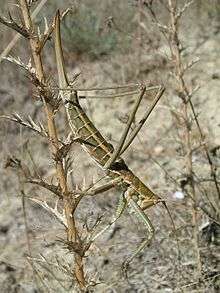Saginae
| Predatory katydids | |
|---|---|
 | |
| Mature Saga pedo | |
| Scientific classification | |
| Kingdom: | Animalia |
| Phylum: | Arthropoda |
| Class: | Insecta |
| Order: | Orthoptera |
| Family: | Tettigoniidae |
| Subfamily: | Saginae Brunner von Wattenwyl, 1878 |
| Genera | |
| |
The Saginae, commonly known as the predatory katydids or predatory bush-crickets, is a subfamily of the family Tettigoniidae (the katydids, long-horned grasshoppers or bush-crickets). The Saginae are specialist carnivores, which is unusual among the Orthoptera.[1] Their specialist carnivory and appropriately adapted digestive tracts even were regarded as unique in the order Orthoptera, but at least some members of two other subfamilies, the Austrosaginae and Listroscelidinae are partly or completely predatory as well, and until recently those subfamilies were included in the Saginae.
Overview

Members of the Saginae are gracile and elongated in build compared to say, most locusts or crickets, but their four anterior walking legs, as opposed to their two posterior leaping legs, are powerful and lined with spines, mainly along their inner edges. They apply those inner spines in clasping their prey. Some species have spines on the outer surfaces and on the leaping legs as well; those external spines probably are defensive in function. The jaws of Saginae are not spectacular, but are large, powerful, sharp, and businesslike, as befits predators, and the insects do not hesitate to bite when handled.
The Saginae are large insects, some species with a body length of more than 50 mm, not counting the antennae or ovipositor, which are long, typically about as long as the body.
The ovipositor is long and sword-like, and used for oviposition in soil.
References
| Wikimedia Commons has media related to Saginae. |